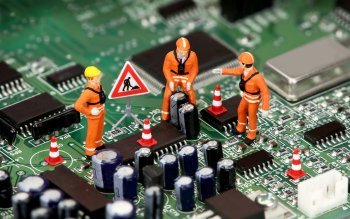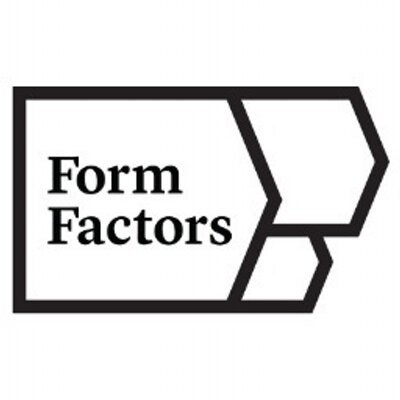Form Factors of the Motherboard
Form Factors off the motherboard:
During the first days of the computer, they made use of the AT form factor and 12 inch wide motherboards. Due to the extreme size off an AT motherboard, this caused problems for the upgrading of personal computers and was not able to be integrated into the newer slim line desktop cases.
Those problems were addressed by the smaller version of the full AT form factor, the baby AT which was introduced in the year 1989. Even though the basic design of the baby AT remained the same, many improvements were made to it.
All motherboard designs are open standard and as such, they do not require certification (to ensure a constant standard between manufacturers). The problem with this is that the can be a massive difference in design detail between manufactures i.e. the actual dimensions of the motherboard. Due to this hindrance, case manufacturers have flourished in that they have gained to ability to focus on one brands motherboard’s form factor, which came as a blessing to home pc builders, modders and PC technicians.
Common Form factors:
- The form factor of motherboards pertain to the size and shape of the board.
- It also describes the physical layout of different components and devices on the motherboard.
- Various form factors exist for mothrboards :
-AT = Advanced Technology
-ATX = Advanced Technology Extended
-Mini ATX = Smaller footprint of ATX
-Micro ATX = Smaller footprint of ATX
-LPX = Low profile extended
-NLX = New low profile Extended
-BTX = Balanced Technology Extended
The Evolution of the Motherboard:
The original PC motherboard had a minimum amount of integrated devices, just ports for a keyboard and a cassette deck (for storage). Everything else, including a display adapter and floppy or hard disk controllers, were add-in components, connected via expansion slots.
Over time, more devices were integrated into the motherboard. It was a slow trend initially though, as I/O ports and disk controllers were often mounted on expansion cards even up to 1995. Other components – typically graphics, networking, SCSI and sound – usually remained separate. Many manufacturers have experimented with different levels of integration, building in some or even all of these components. However, there are drawbacks. It’s harder to upgrade the specification if integrated components can’t be removed, and at first highly integrated motherboards often required non-standard cases. Furthermore, replacing a single faulty component may mean buying an entire new motherboard.
Consequently, those parts of the system whose specification changes fastest, particularly RAM and CPU, tend to remain in sockets or slots for easy replacement. Similarly, parts that not all users need, such as SCSI, are usually left out of the base specification to keep costs down. However, it’s now common for sound, video and/or network support to be included in motherboards, particularly as technology miniaturization has allowed greater space within the motherboard form factor and Flash BIOS and EPROM has allowed greater support for updated technologies.
Motherboard Development:
Motherboard development consists largely of isolating performance-critical components from slower ones. As higher speed devices become available, they are linked by faster buses – and the lower-speed buses are relegated to supporting roles. There are cost benefits to putting peripherals designed as integrated chips directly onto the motherboard, but the biggest downside is the restriction of future upgrade options. However, the flexibility of the open IBM architecture, the basis of the modern PC motherboard allowing the attachment of peripherals and opening the door to the modern PC, allows for many options. Whether the PC buyer opts for low cost integration or high powered flexibility, this is the reason that PC motherboards are so widely varied and yet so integrally compatible with all PC software.
The End
References:
https://en.wikipedia.org/wiki/Computer
https://en.wikipedia.org/wiki/AT_(form_factor)
https://en.wikipedia.org/wiki/Motherboard
https://www.computerhope.com/jargon/b/babyat.htm
https://en.wikipedia.org/wiki/Certification
https://en.wikipedia.org/wiki/Brand
https://en.wikipedia.org/wiki/Modding
https://en.wikipedia.org/wiki/Computer_repair_technician
http://www.businessdictionary.com/definition/component.html
http://www.dictionary.com/browse/minimum
http://www.dictionary.com/browse/integrated
http://searchnetworking.techtarget.com/definition/port
https://en.wikipedia.org/wiki/Computer_keyboard
https://en.wikipedia.org/wiki/Cassette_deck
https://www.pcmag.com/encyclopedia/term/41533/display-adapter
https://en.wikipedia.org/wiki/Floppy_disk
https://en.wikipedia.org/wiki/Disk_controller
https://www.computerhope.com/jargon/e/expaslot.htm
https://www.computerhope.com/jargon/i/ioport.htm
https://en.wikipedia.org/wiki/Expansion_card
https://en.wikipedia.org/wiki/SCSI
https://en.wikipedia.org/wiki/Random-access_memory
https://en.wikipedia.org/wiki/Central_processing_unit
https://en.wikipedia.org/wiki/Miniaturization
http://blog.superuser.com/2011/04/03/what-is-flashing-the-bios/
https://en.wikipedia.org/wiki/EPROM
https://www.merriam-webster.com/dictionary/development
https://dictionary.cambridge.org/dictionary/english/isolate
http://www.douglocke.com/Downloads/Performance-Critical%20Systems%20White%20Paper.pdf
https://en.wikipedia.org/wiki/Bus_(computing)
https://en.wikipedia.org/wiki/Peripheral
https://en.wikipedia.org/wiki/IBM
https://www.pctechguide.com/motherboards/evolution-of-the-motherboard
http://www.utilizewindows.com/types-of-computer-cases-and-motherboard-factors/
https://www.cengage.com/resource_uploads/downloads/1435487389_223130.pdf
https://www.sqa.org.uk/e-learning/HardOSSupp01CD/page_30.htm
https://www.computerhope.com/jargon/f/formfact.htm
https://turbofuture.com/computers/motherboard-form-factors
Images are linked to their sources in their description


Good information technologi j
thank you so much
Dont copy and paste information, hoping to get an upvote. It's not fair on other users! People put time and effort into doing research and writing their own informative article.
I copied this section and googled it:
And I found you took it from somewhere like here:
http://www.oocities.org/media_h/Technology/Documentations/System_Boards_Technical_Details.htm
It's not FAIR. Write your own stuff!
Congratulations @epictus! You have received a personal award!
Click on the badge to view your Board of Honor.
Do not miss the last post from @steemitboard:
Congratulations @epictus! You received a personal award!
You can view your badges on your Steem Board and compare to others on the Steem Ranking
Vote for @Steemitboard as a witness to get one more award and increased upvotes!